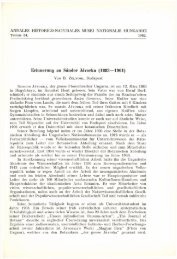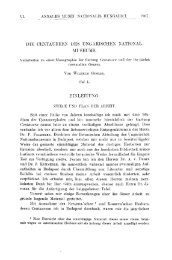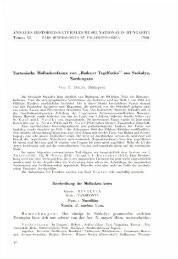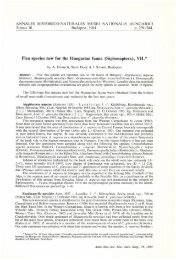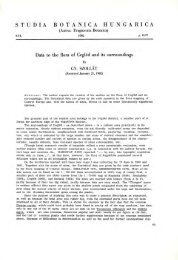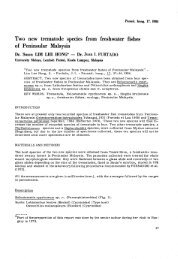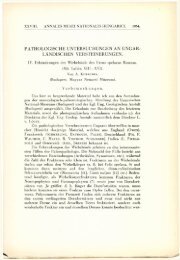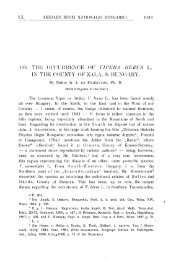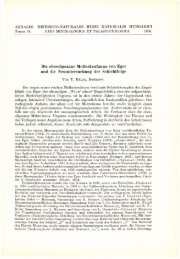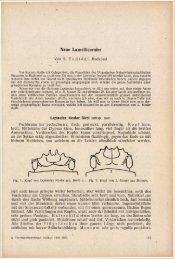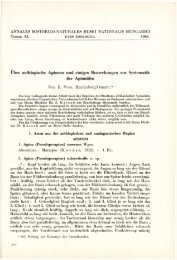New and little-known species of Carabidae from the Middle East and ...
New and little-known species of Carabidae from the Middle East and ...
New and little-known species of Carabidae from the Middle East and ...
You also want an ePaper? Increase the reach of your titles
YUMPU automatically turns print PDFs into web optimized ePapers that Google loves.
36 E. Kirschenh<strong>of</strong>er<br />
(Fig. 25)<br />
sp. n.<br />
Type material – Holotype (female): “India, Orissa, Jaipur – Keonjahr, Distr. Daitari,<br />
leg. Gy. Topál/No. 1012, <strong>from</strong> under bark, 4. XII.1967” (HNHM).<br />
Description – Habitus: Fig. 25. Length 5.6 mm, width 2.7 mm; shape ra<strong>the</strong>r broad,<br />
ovoid, distinctly convex. Colour <strong>and</strong> lustre: head light brown; pronotum reddish brown,<br />
wide sides distinctly lighter; elytra darker brown, each with two transverse yellowish spots;<br />
anterior spot broad, serrated anteriorly <strong>and</strong> posteriorly, covering intervals 2 to 7; posterior<br />
spot similarly serrated, covering intervals 2–8 but abbreviated on 6; m<strong>and</strong>ibles, palpi, antennae<br />
<strong>and</strong> legs reddish yellow, tibiae slightly darkened; head <strong>and</strong> pronotum distinctly<br />
microsculpted <strong>and</strong> matt, elytra more shiny. Head: eyes strongly protruding; temples moderately<br />
long, obliquely narrowing to neck; labrum much longer than wide, anteriorly<br />
straightly truncate; m<strong>and</strong>ibles ra<strong>the</strong>r long, conically narrowing towards apex; head without<br />
characteristic features. Pronotum: 1.65 times as wide as long, sides medially weakly angled,<br />
with setigerous puncture in this angle; sides distinctly <strong>and</strong> roundly narrowing towards<br />
broadly rounded <strong>and</strong> weakly projecting anterior angles, narrowing to obtuse-angled posterior<br />
angles in straight line; marginal groove narrowing anteriorly, wider posteriorly; anterior<br />
margin clearly sinuate; base ra<strong>the</strong>r straight with distinct prebasal transverse depression<br />
which bilaterally merging with basal impressions, <strong>the</strong>se broad, distinctly depressed but<br />
vaguely marked; median line ra<strong>the</strong>r deeply incised, not reaching anterior margin or base.<br />
Elytra: elongate <strong>and</strong> ovoid, moderately wide, strongly convex, sides weakly rounded <strong>and</strong><br />
widening posteriorly, briefly declivous before apex; anterior margin entire, nearly straight,<br />
roundly joining lateral margin; striae ra<strong>the</strong>r deep, very finely <strong>and</strong> densely punctate at bottom;<br />
intervals ra<strong>the</strong>r flat. Microsculpture: head roundly reticulate; pronotum <strong>and</strong> elytra<br />
very finely transversely reticulate; dorsum with silky lustre due to microsculpture.<br />
Distribution – India: Orissa.<br />
Etymology – The <strong>species</strong> is named after its geographical origin.<br />
Comparisons – This <strong>species</strong> resembles Trichocoptodera maculata<br />
LOUWERENS, 1958 in shape <strong>and</strong> size, but is more slender, with elytral sides<br />
before apex less declivous, humeral spot on fourth interval not as far elongated<br />
towards middle <strong>and</strong> preapical spot much larger <strong>and</strong> wider.<br />
(Fig. 26)<br />
sp. n.<br />
Type material – Holotype (female): “Indonesia, SE-Sulawesi, Kendari Airport,<br />
30 km W <strong>of</strong> Kendari, 11.–14.2.1994, leg. M. Strba & I. Jenis” (NMW).<br />
Annls hist.-nat. Mus. natn. hung. 102, 2010



